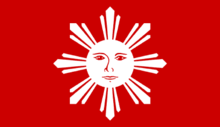Distrito de Morong
The Politico-Militar Distrito de Morong or Distrito de Morong was a province in the Philippines created out of the province of Manila and a part of Laguna on February 23, 1853 by a decree of the Superior Gobierno, composing Morong, Pililla, Tanay, Baras, Binangonan, Jalajala, Angono and Cardona from Laguna; and Antipolo, Boso-Boso, Cainta and Taytay from Manila. The offices were housed at a building now known as Commandancia. Its first military governor was Francisco Turrentigue.[1]
Creation of the District
Three years after the issuance of Royal Decree of Spain in 1844, provincial organizations were reclassified into provinces, districts, and politico-military units. At that time, the province of Manila had religious jurisdiction over Pueblo de Morong and Laguna over all governmental, commercial, industrial and social affairs. Politico-Militar Distrito de Morong was created out of these provinces. It took its name from the capital village Morong, located at the shore of the Laguna de Bay, with villages under the supervision of the Franciscans.[1]
Pueblos of Distrito de Morong
The following is a list of the pueblos comprising Distrito de Morong.[1]
| Pueblo | Year Created | Population in 1876 |
|---|---|---|
| Morong | 1853 | 6,079 |
| Pililla | 1583 | 3,276 |
| Baras | 1595 | 1,156 |
| Tanay | 1606 | 4,609 |
| Antipolo | 1650 | 3,435 |
| Taytay | 1675 | 7,425 |
| Bosoboso | 1700 | 529 |
| Binangonan | 1737 | 6,705 |
| Cainta | 1760 | 1,733 |
| Angono | 1766 | 1,739 |
| Jalajala | 1823 | 1,245 |
| Cardona | 1855 | 2,107 |
On February 11, 1879, the creation of the town of Teresa was approved, merging the four former sitios of the town of Morong, namely, Santa Rosa, Prinza, Pantay and Buhangin.[1]
Katipuneros in Morong

Before the outbreak of the Philippine Revolution, a branch of the Katipunan was created in Morong, the capital of the district. Many leaders of the Katipunan were from Distrito de Morong. Among the very first initiates of the Katipunan was Aurelio Tolentino who hailed from Morong. He and his brother Jacinto were Andres Bonifacio's agents. Teodoro Plata, one of original founding members, was a clerk in the Court of Justice of the Peace of Morong.[1]
There were a number of attacks made by the Katipuneros and Spaniards who took their stand in the Commandancia and Morong Church and convent. The last stronghold of Spain in Distrito de Morong happened when the Spaniards surrendered to the Katipuneros on August 19, 1898.[1]
After the surrender of the Spaniards in Morong, Antipolo became the capital of the revolutionary army, removing the title of Morong as capital of the district.[1]
Distrito de Morong earned the distinction to be represented as one of the eight rays of the sun in the Filipino flag, symbolic of the eight provinces who held uprisings against the Spaniards in 1896 which were Manila, Bulacan, Pampanga, Nueva Ecija, Morong, Laguna, Batangas, and Cavite.[1]
Commander Hilarion Raymundo and the Morong Defenders
Major Hilarion Raymundo was the leader of the Morong defenders who fought the Americans during the Philippine-American War. Under his leadership, the Americans were forced to retreat after killing and wounding many of them in February 1900. Many Moronguenos were still fighting the Americans even after the surrender of Manila and capture of Emilio Aguinaldo at Palanan on March 23, 1901. However, Don Juan Sumulong advised the Moronguenos to surrender to the American flag.[1]
The Creation of Rizal Province
To hasten the establishment of the civil government in the Philippines, former United States President William McKinley sent the Second Philippine Commission. It conducted public meetings with the people regarding the reorganization of the provinces. On June 5, 1901, two hundred twenty one delegates from the Distrito de Morong and a portion of Manila Province had an assembly at Pasig Church. Judge William Howard Taft stated that it was suggested to the Commission to unite Manila and Morong.[1]
Hilarion Raymundo and Jose Tupas, two of the Morong delegates, argued against the fusion of Manila and Morong while Jose Oliveros and Juan Sumulong, delegates of Antipolo, were in favor of it.[1]
After the deliberation, Trinidad Pardo de Tavera suggested that the merged provinces be named Rizal "...in memory of the most illustrious Filipino and the most illustrious Tagalog the islands had ever known...".[1]
References
- Pascual, Timoteo; Guillermo, Liwayway (1978). Morong's 400 Years. Manila: UST Press.